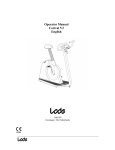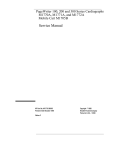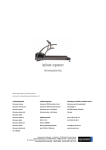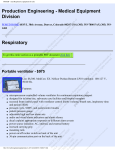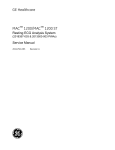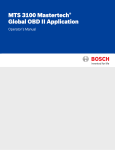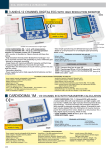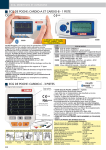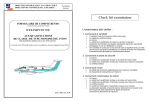Download Excalibur RS-230-DP User guide
Transcript
Operator Manual Corival V3 English Lode BV Groningen, The Netherlands 0344 Operator manual Corival This is the short operator manual for the Lode Corival Ergometer, which describes the basic actions for starting up your ergometer. For a complete description, we refer to our User Guide. Intended Use A Lode ergometer is a diagnostic tool intended to be used as a stress test device in a medical environment. The main goal of the use of a Lode ergometer is to create reproducible stress tests. The following parameters can be measured: Workload (watt) Revolutions per minute (rpm) Time (minutes and seconds) Distance (km) Optional: Blood Pressure (mmHg) Optional: Heart rate (beats per minute) Optional: Energy (KiloJoules) Optional: SpO2 In combination with other diagnostic tools, like ECG or pulmonary function equipment, other important physiological data can be obtained, allowing a physician to evaluate a test subjects physical status. A Lode ergometer is designed both for manual operation and for control by external ECG-, pulmonary equipment. In combination with optional software, the ergometer can also be controlled by a PC. The ergometer has to be operated under the supervision of well-trained medical specialists, like cardiologists, pulmonologists and physiotherapists. The ultimate judgment whether a test subject should undertake a stress test with an ergometer and which protocols should be used must be made by the responsible medical specialist, based on the limitations of each individual, the medical history and all other applicable circumstances. Neither Lode BV nor its distributors assume any responsibility for the final use of its equipment. Contra Indication The Corival ergometer is to be operated by classified personnel only. As stated in the intended use, the Corival is intended to be used in a medical environment. During the intended use the test subject will deliver energy. Application of the wrong dosis of energy could lead to permanent damage of the test subject health. Maintenance The Corival should be calibrated once a year. In case any damage is observed of the Corival Lode B.V. or his representative should be informed in order to execute the necessary repair(s). Service of the Corival is restricted to factory-trained personnel only. Precautions Caution: This device should only be sold by, or on the order of authorized persons. Operator manual Corival Caution: Not suitable for use in the presence of flammable anaesthetics. Note: The voltage selector (115/230VAC) is inside the ergometer. The main unit panel has to be unscrewed. Voltage selection should be done by a technician! Possible hazards Using the Corival according to intended use, contra indications, maintenance, precaution and common sense stated above may not eliminate all hazards. Possible residual hazards could be: wrong installation, wrong use, wrong dose, wrong interpretation of readings, mechanical breakdown of parts, software failure. LIST OF SYMBOLS USED On/Off switch External Input External Output Type B Electrical Safety Separate collection of electric and electronic equipment Copyright Lode BV, February 2008, All rights reserved. Manufacturer information: Lode BV Zernikepark 16 NL-9747 AN Groningen, The Netherlands t: +31 50 571 28 11 f: +31 50 571-67 46 @: [email protected] www.lode.nl Operator manual Corival TABLE OF CONTENTS 1 DESCRIPTION OF THE CORIVAL ERGOMETER 1.1 1.2 1.3 MANUAL CONTROL QUICK START ANALOG EXTERNAL CONTROL TERMINAL – DIGITAL EXTERNAL CONTROL VIA RS232 2 MAIN MENU 3 SYSTEM PARAMETER 3.1 3.1.1 3.1.2 3.1.3 3.1.4 3.1.5 3.1.6 3.2 3.3 3.3.1 3.3.2 3.3.3 3.3.4 3.3.5 3.4 3.4.1 3.4.2 3.4.3 3.4.4 3.4.5 3.4.6 3.4.7 3.4.8 4 SPECIFICATIONS 4.1 4.2 5 TECHNICAL SPECIFICATIONS FUSES COMMUNICATION PORTS 5.1 5.2 5.3 5.4 A SET DISPLAY Power RPM Heartrate Torque Timer Distance SET P-SLOPE SET MODE Hyperbolic HR controlled Linear Fixed Torque Isokinetic (only available for Excalibur Sport 925900) SETTINGS Default Startmenu Keyboard On/Off Test Functions P In/Out Analog TC Bytes RS232 Protocol Language Device No RS232 LOOP CONNECTION RS-232 SPECIFICATIONS ANALOG IN/OUT Maintenance A.1 A.2 B Cleaning Replacing fuses Programmable Display Unit 928810 B.1 Installing the Programmable Display Unit (option 928810) B.2 Control panel Corival with Programmable Display Unit (option 928810) B.3 Using the Programmable Display Unit B.3.1 Menu structure programmable control unit B.3.2 Manual menu B.3.3 Analog menu B.3.4 Terminal menu B.3.5 System parameters menu B.3.6 Operation from basic control panel B.3.7 Protocol C Heart rate option 928924 C.1 Connecting the Heart rate system (option 928924) 6 7 8 8 9 10 10 10 10 10 10 10 10 10 11 11 11 11 11 11 11 11 12 12 12 12 12 12 12 13 13 13 14 14 14 14 14 15 15 15 16 16 16 16 17 18 18 19 19 20 21 27 27 Operator manual C.2 C.3 D Using the Heart rate option Installing the BP cuff Blood pressure option 928817, -818, 820 D.1 D.2 D.2.1 D.2.2 D.3 D.4 D.5 D.6 E 28 28 29 29 29 31 31 32 33 34 0 Watt Start-up System 906805 36 F.1 F.2 G Using the BP system Patient Hook-up Apply the cuff Position of the cuff Abort codes BP system Cleaning and disinfection Cleaning of the cuff: Installing the BP cuff 27 27 SpO2 option 928840 E.1 E.2 F Corival Precautions for Use Using the SpO2 Option Using the 0 Watt start-up system 0 Watt Start-up system with P-display RS232 Connections G.1 Overview 34 34 36 36 38 38 Operator manual Corival 1 Description of the Corival ergometer The control panel consists of the following elements: 1. 2. 3. 4. 5. 6. Led indicator for rpm. Display A directed to test subject. Down button. Up button. Confirmation button. Ergometer type indication. Fig. 1 Control Panel standard Corival The back panel of the Corival contains the following elements: 1. 2. 3. 4. 5. 6. 7. 8. 9. Mains on/off switch Mains connector Fuse Fuse Dealer information label (if used) RS232 in RS232 out Analog i/o Protective Earth connector Fig. 2 Back panel connections 6 Operator manual Corival Adjustability The ergometer is adjustable to test subjects of most sizes and ages. • The height of the saddle can be adjusted by tilting the handle on the back underneath the saddle • The height of the handlebars can be adjusted by loosening the handle in front of the ergometer. Moving the ergometer The ergometer can be moved by turning it over to the right (appr. 30º) when you are in front of the handlebar. A wheel in the middle of the ergometer drops out. You can now drive the ergometer to its location. Turn it over to the left (appr. 30º) and the wheel in the middle will fold in. The ergometer is ready for use. Instructions for installing the Corival ergometer 1. Place the ergometer in the location where it will be used. 2. Check (at your supplier) whether the voltage set for the ergometer is set correct. 3. Connect the power cord first to the socket of the ergometer and then connect it to the line voltage. 4. Switch the power switch on. The indicator lamp in the switch lights up. If the initialisation screen with the software version will appear for a few seconds, the ergometer is ready for use. 1.1 Manual control quick start If the Corival is switched on, the default startup menu is the entrance to the MAIN MENU. Press the confirmation button ( ) to enter the main menu. Select with the arrow keys ▼▲ the MANUAL MODE. Press ( ) and you will see the following screen: P= 0W 0 rpm MANUAL With the ▼▲ keys the workload can be in- or decreased. The workload will rise with 25 watt/sec when the rpm is above 30. Keeping the ( ) pressed for a few seconds allows you to go up one or more menu levels. During cycling, the display shows the following information: • the top line shows 1 or more ergometry parameters. • the bottom right corner shows the current control mode. • at the bottom left position the selected adjustable parameter is shown. 7 Operator manual 1.2 Corival Analog external control Execute the following steps to control the Corival externally using the analog in-/output: 1. Connect the external controling device (e.g. ECG system) with a correct cable to the analog i/o port. 2. Start the ergometer and go in the main menu to ANALOG. 3. Now the ergometer can be controlled by an external device with an analog signal. 1.3 Terminal – digital external control via RS232 For digital external control using the RS232 serial port execute the following steps for the basic Corival: 1. Connect the Corival to the external control device (i.e. ECG system, PC) using a correct RS232 cable 2. Switch on the ergometer and select the menu TERMINAL on the display. 3. Be sure that the correct protocol has been selected under the menu SYSTEM PARAMETERS / SETTINGS / RS232 PROTOCOL For a list of available protocols and ECG system, we refer to the user guide or your local dealer. If you usually control your ergometer from an ECG system in the TERMINAL MODE, you can set this mode as default startup menu. The Corival is now ready for digital external control. Another option to control the ergometer from a pc is with the Lode Ergometry Manager (LEM, article 92890X) software. This uses the Lode 38k4 protocol. 8 Operator manual Corival 2 Main menu When the ergometer is started after pressing the confirmation button ( ) you enter the MAIN MENU. The following submenus are selectable from the main menu: ! TERMINAL ! MANUAL ! ANALOG ! SYSTEM PARAMETER Use the arrow keys▼▲ to scroll through the menus. Press the ( ) button to select a menu. Keeping the ( ) pressed for a few seconds allows you to go up one or more menu levels, wherever you are in the menu. The complete menu structure is shown below. In front of each menu the level depth is indicated. 0. MAIN MENU 1. ANALOG 1. MANUAL 1. TERMINAL 1. SYSTEM PARAMETER 2. SET DISPLAY 3. POWER 3. RPM 3. HEARTRATE 3. TORQUE 3. TIMER 3. DISTANCE 2. SET P-SLOPE 2. SET MODE 3. HYPERBOLIC 3. HR CONTROLLED 3. LINEAR 3. FIXED TORQUE 3. ISOKINETIC (only available for Excalibur Sport 925900) 2. SETTINGS 3. DEFAULT STARTMENU 3. KEYBOARD ON/OFF 3. TEST FUNCTIONS 3. P IN/OUT ANALOG 3. ECG TRIGGER 3. TC_BYTES 3. RS232 PROTOCOL 3. LANGUAGE 3. DEVICE NO 3. SEATING POSITION (only available for Excalibur Sport 925900) 9 Operator manual Corival 3 System parameter In the System Parameters different specific ergometer settings can be carried out. 3.1 Set display This function allows you to adjust the parameters which can be read out on the display during exercising. If more then 2 are set to ON they are shown in groups of 2 scrolling. Choosing default allows you to go to factory settings for the display parameters. Press the ( ) button to go to the next parameter and switching the actual parameter ON/OFF is done with ▼▲ keys. 3.1.1 Power Power indication in watts can be switched ON or OFF using the ▼▲ keys. The power displayed is the actual power of the brake. This means that regulation speed is incorporated. When rpm drops below 25 rpm the load is removed at once, because the pedal torque becomes very high. Load is put on the brake when rpm is greater or equal to 30 rpm. 3.1.2 RPM Switch ON or OFF the Cadence readout in Revolutions per minute. The rpm can always be read out by the LED bar graph on top of the display independent of this adjustment. 3.1.3 Heartrate Switch ON or OFF the Heart rate indication in beats per minute. The ♥ symbol is used in the display. 3.1.4 Torque Switch ON or OFF the Torque in the readout. The Torque is displayed in Newton meter. 3.1.5 Timer Switches the Timer ON or OFF in the readout. The timer is shown in the display as: Θ = mm:ss. The timer starts when you enter manual, terminal or analog mode and the rpm increases above 30. The timer is reset when one of these modes is left. 3.1.6 Distance Switches the distance ON or OFF. The distance is shown in the display as: → = 99,9 km, expressing the distance in km. A fictive formula is used (see main manual), holding only for average cycle conditions and it should not be used for diagnostic purposes. 3.2 Set P-slope The load regulation steepness is set by this parameter to the default norm-value of 25 watt/sec or to maximal. During the Wingate sprint test the P-slope has to be unlimited. 10 Operator manual 3.3 Corival Set mode Set mode is used to define which parameter (like load, torque, heart rate and linear constant alpha) has to be adjusted during exercising in MANUAL mode with▼▲ keys 3.3.1 Hyperbolic Hyperbolic mode means that the load P can be adjusted in watt. The load is kept constant independent of rpm. 3.3.2 HR controlled Heart rate can be adjusted and the load is regulated until the adjusted heart rate is reached. This means when heart rate increases above the adjusted level load is decreased and the other way around. 3.3.3 Linear In linear mode the load P is coupled with rpm using the following formula: P [W] = α* (n [min-1] )2 The linear coupling constant α is the adjustable parameter in this case. 3.3.4 Fixed Torque In Fixed Torque mode the load is regulated such that the torque is kept at a set fixed value, according to the formula: T [Nm] = (P*60) / ( 2 * π * n [min-1]) Note: be aware of the fact that this fixed torque mode is not the same as the constant Torque mode which is used with the Wingate software module (see for more information the Wingate manual). 3.3.5 Isokinetic (only available for Excalibur Sport 925900) In the Isokinetic mode the rpm is kept constant during the exercise, according to the formula: -1 P [W] = ( 2 * π * n [min ]*T [Nm]) / 60 During the exercise you can not pedal faster then the chosen rpm. You can deliver more Force with the same speed and produce more workload in this way. Note: The rpm is the adjustable parameter in this case, this mode can be used to define the optimal rpm. 3.4 Settings Under settings all device specific and interface adjustments can be made. It concerns to all those items not related directly to ergometry. 3.4.1 Default Startmenu Normally your ergometer starts in the main menu. But you can modify this menu to your own desired settings. This is convenient when your ergometer is used often in the same setting, The following menus can be selected as startmenu: MAIN MENU; MANUAL; TERMINAL; ANALOG At the next startup of your ergometer the selected menu will be activated. 11 Operator manual 3.4.2 Corival Keyboard On/Off If you do not want to interrupt a training or you do not want the test subject to interrupt the training by pressing a key accidentally, the possibility is offered to disable the keyboard Now you wonder how to get back the control to the keyboard. Act as follows: Switch off the ergometer Switch it on again while keeping the ( ) button pressed. Now you have back the control. Go to SYSTEM PARAMETERS / KEYBOARD ON/OFF and set it to ON. At the next startup of the ergometer the keyboard is enabled again. 3.4.3 Test Functions For servicing and calibration of the device a number of diagnostic tools is available in the software. They are hidden under Test functions. You need a safety code to enter the TESTFUNCTIONS. 3.4.4 P In/Out Analog The ergometer can be controlled by an external device which has an analog output only. This is done using the ANALOG mode. With P In/out Analog the analog scaling can be adjusted: - 1 V analog in - can correspond with a workload of 100 W / 200 W / 500 W. 3.4.5 TC Bytes The Test code (TC) Bytes offer in case of malfunction or poor performance of the BP option the possibility to make error codes visible. Your local distributor can help you diagnose the problem with the Error Code. 3.4.6 RS232 Protocol When the ergometer is externally controlled via RS232 a protocol should be selected here. 3.4.7 Language You can choose different languages for the ergometer. 3.4.8 Device No When RS232 communication is used with the ergometer, it is identified with a so called device number. This offers the possibility of looping through ergometers. 12 Operator manual Corival 4 Specifications 4.1 Technical Specifications Principle Mains voltage Frequency Patient capacity Power consumption Workload Device control Accuracy : : : : : : : : Read-out workload Read-out pedalling speed : : eddy current brake small disk. 115-230 VAC (adjustable) 50 Hz, 60 Hz. 350 lb - 160 kg. 120 VA. 0-999 W HYP, 0-999 W LIN manual, external analog, external digital < 3 W for P <= 100 W, < 3% for 100 W< P<500W, <5% for P>500 W. digital, 0-999 resolution 1 W. analog 0-180 rpm or digital 0-255. Output workload Output pedalling speed Input voltage for external control : : : 100, 200 or 500 W 100 min-1 1 V. 100,200 or 500 W Safety class Corival Safety class Corival + BP option : : I type B, IEC 601-1 chapter 18, 19 and 20. IIa type B, IEC 601-1 chapter 18, 19 and 20. Leakage current Isolation resistance Earthway resistance : : : < 0.4 mA. > 4 MΩ. < 0.2 Ω. Zero load Noise level : : < 8 W at 60 rpm. +/- 60dB at workload 200W/60rpm +/-80cm from crank. 4.2 115 V 230 V 1 V (max. 999 W). 1 V (max. 999 W). Fuses : : 2 x 1,60 A slow. 2 x 0,80 A slow. 13 Met opmaak: opsommingstekens en nummering Operator manual 5 Corival Communication ports This chapter describes the communication ports in the main unit panel of the Corival: ! RS232 (two ports for RS232-in and loop connection RS232-out) ! Analog in/out 5.1 RS232 The Corival has two RS232 connectors for loop-connecting a number of Corival’s and for communication with a personal computer or an ECG device. When the ergometer is controlled externally always use the RS232-in port. Via RS232 an ergometer can be monitored and settings can be entered with a computer. See main manual for App E for protocols and cabling for your controlling device and the Pin layout RS232 connector 5.2 Loop connection It is possible to control several Corival ergometers with one external device using RS232. Connect the RS232-in connector to the external device. Connect the RS232-out connector to the RS232-in connector of the following Corival ergometer, and so on. The maximum number of Corival ergometers that can be connected in this way is 8. Use the device number option in SYSTEM PARAMETERS to give each Corival a unique number. In this way each Corival can be controlled separately, using the LEM software. 5.3 RS-232 specifications See main manual for detailed information 5.4 Analog in/out This connector can be used to connect the Corival to other analog controlling instruments. See main Manual for detailed information. 14 Operator manual A Corival Maintenance The Lode Ergometer is mechanically and electronically designed for durability and accuracy. This also accounts for the options and add-ons of the device. The frequency of calibration depends on the intensity of usage. As a rule Lode Ergometers are calibrated on an annual basis. Please refer to the Service Manual for specific details on check-up intervals for the Lode Ergometer and its options and/or add-ons. The dynamic calibration is performed using calibration equipment specially designed by the manufacturer. A.1 Cleaning The housing of the Corival ergometer and all other external surfaces can be cleaned with a cloth dampened with non-aggressive liquid. A.2 Replacing fuses You will not need a certified technician to replace fuses of the Corival. Always disconnect the power cord first! Unplug the mains cable. The fuses are part of the main unit (Fig. 3 Main unit panel connections, item 8) and located at the bottom of the main unit. You have to lift the Corival place it in the upright position (90°) to locate the fuses. Unscrew the fuse holders with a screwdriver, replace the broken one and place them back again. Note: make sure that the fuses that are in the Corival match the set voltage (115 V: 2 x 1,25 A slow; 230 V :2 x 0,63 A slow). Contact your local dealer for a maintenance contract or ask Lode: LODE BV Service department Zernikepark 16 9747 AN Groningen The Netherlands Tel. +31 50 5712811 Fax. +31 50 5716746 Email: [email protected] Internet: www.lode.nl 15 Operator manual B Corival Programmable Display Unit 928810 B.1 Installing the Programmable Display Unit (option 928810) When the option 928810 is ordered later on, it should replace the standard Control Unit. Replacement should be carried out by service personnel only. For the description, we refer to our user guide supplied with this ergometer. B.2 Control panel Corival with Programmable Display Unit (option 928810) 1. 2. 3. 4. 5. 6. Display B (4x20 characters) directed to operator Infrared window (only active for option 928820) One-step-back button Down button Up button Confirmation button Fig 1: Control Panel with Programmable Display Unit B.3 Using the Programmable Display Unit Check if the ergometer is properly installed. In the display of the basic control panel the following appears for a few seconds: LODE ERGOMETER TBD Followed after a few seconds by: P= 0W 0 rpm At the same time the programmable control panel shows for a few seconds: 16 Operator manual Corival LODE P-display ver X.YZ In case the Blood pressure option is available it is followed for approximately 1 second by the text "BPM Initialized "thereby indicating correct operation of the BP device. The SpO2 comes together with the P-Display. When this option is available correct operation is indicated by the text "SpO2 Initialized" In case the 0-Watt Start -up System is available the text "0 Watt Initialized" is displayed indicating the 0-Watt Start -up System is detected When all three options are installed the display shows: LODE BPM Initialized SpO2 Initialized 0 Watt Initialized Then the main menu appears: system parameter TERMINAL manual Term The menu displayed in capitals can be selected. As extra reminder the first 4 letters of the selectable mode are showed above the confirmation button. With the ▼▲ keys you can scroll through the other menus and select SYSTEM PARAMETERS, MANUAL, ANALOG or PROTOCOL. With the right ( ) confirmation button the menu in capital can be selected. The left ( ) escape button is used to go back one level in the menu structure. The ergometer is now ready for use. If nothing appears in the display(s), check whether the power cord and the control unit have been properly connected or contact your supplier. B.3.1 Menu structure programmable control unit 0. MAIN MENU 1. ANALOG 1. MANUAL 1. TERMINAL 1. SYSTEM PARAMETER 2. SET DISPLAY 3. POWER 3. RPM 3. HEARTRATE 3. TORQUE 17 Operator manual Corival 3. TIMER 3. DISTANCE 3. TARGET HR* 3. ENERGY* 2. SET P-SLOPE 2. SET MODE 3. HYPERBOLIC 3. HR CONTROLLED 3. LINEAR 3. FIXED TORQUE 3. ISOKINETIC (only available for Excalibur Sport 925900) 2. SETTINGS 3. DEFAULT STARTMENU 3. ECG START* 3. P IN/OUT ANALOG 3. CONTRAST 3. ECG TRIGGER 3. TC_BYTES 3. RS232 PROTOCOL 3. LANGUAGE 3. DEVICE NO 3. SEATING POSITION (only available for Excalibur Sport 925900) 1. PROTOCOL* 2. PROTOCOL EDIT * 2. PROTOCOL RUN * 3. ÅSTRAND PROTOCOL* 2. PROTOCOL DELETE * Compared to the standard version the *menus are added. B.3.2 Manual menu Selecting the manual mode will show you (default) the following display at the programmable control panel: MANUAL P = 0W ♥ = 0/m* esc 0 rpm P BPM* * BPM is displayed when this option is available, otherwise another MENU possibility is active. With the ▼▲ keys you can increase or decrease the parameter of the selected mode. In the middle the adjustable parameter is shown, f.i. the load P (to be set with SYSTEM PARAMETERS> SET MODE) B.3.3 Analog menu Selecting the ANALOG menu will show the following screen at the programmable panel: ANALOG P = 0W ♥ = 0/m* esc 0 rpm esc 18 Operator manual Corival Notice: ♥ = 0/m* Only displayed if HR option is being installed! The ergometer is now ready for external control with an analog signal as previously described. See for more information about analog control the user guide (only available in English) supplied with the ergometer. B.3.4 Terminal menu Selecting the TERMINAL menu will show the following screen at the programmable panel: TERMINAL P = 0W ♥ = 0/m* esc 0 rpm esc Notice: ♥ = 0/m* Only displayed if HR option is being installed! The ergometer is now ready for digital external control. For more information about digital external control using the RS 232 serial port see the user guide supplied with the ergometer. B.3.5 System parameters menu In the SYSTEM PARAMETERS different ergometry specific settings can be carried out as described previously in the standard manual. On the programmable control panel you can select the desired menu: set p slope SET DISPLAY settings syst set The menu displayed in capitals and repeated with an abbreviation under the confirmation button ( ) is the one which can be activated. Selecting one of these menus will show you a more extended display then described previously in this manual. As you can see with the example of SET DISPLAY: POWER On esc off on next 19 Operator manual Corival Where the function POWER is the same as described previously in this manual (power indication on or off), the button ESC will bring you back to the system parameters menu. With the ▼▲ keys you can select the power indication to be ON or OFF, and NEXT will bring you to the next item of the SET DISPLAY menu. Beside the parameters RPM, HEART RATE, TORQUE, TIMER and DISTANCE two more are parameters are added: TARGET HEART RATE and ENERGY. Selecting the target HR parameter will show you the target heart rate programmed in the heart rate controlled protocol beside the actual heart rate. For instance: 2 t=00:48 θ=01:12 P= 23 W 61 rpm ♥= 91/min t♥=100/min rec rec Selecting the energy parameter will show you the total amount of mechanical energy delivered by the test subject going into the ergometer in the form of mechanical motion, during the exercise test. Instead of 2 items you can show 4 items out of your selection at once, they will scroll in groups of 2. When you select 4 parameters, there will be no scrolling but a fixation on the display of these parameters. You can program the parameters (also up to 4 without scrolling) at the basic control panel as well, but you have to switch the control over to the basic side first as is described in the next paragraph. The menu SETTINGS will give you the opportunity to select PROTOCOL as a default startmenu besides the previously described menus ANALOG, MANUAL, TERMINAL and SYSTEM PARAMETERS. An extra option for the Programmable control unit in the menu SETTINGS is the CONTRAST adjustment for the P-display. Adjusting contrast shows direct effect on the display. Only after confirmation with SAVE the new contrast is kept! B.3.6 Operation from basic control panel With the basic control panel as described previously in this manual you had the possibility to switch your KEYBOARD ON or OFF. With the programmable control panel the basic (test subject) side of the unit is default OFF. It is possible to control the ergometer with the buttons of the basic control panel instead of the programmable control panel. You can use this option for service purposes or to program the display of the basic control panel. During the startup of the ergometer you can press one of the buttons at the basic side to switch operation to this basic control panel, you will then loose the control function of the programmable side. To go back to the default control situation you have to restart the ergometer without pressing any button. The TEST FUNCTIONS are only available at the basic control panel. They are meant for service personnel only. Contact your supplier in case service of the device is required. If, 20 Operator manual Corival accidentally, you get into to the TEST FUNCTIONS it can cause damage to the ergometer operation and guarantee will be lost! B.3.7 Protocol In this paragraph the program possibilities under the menu PROTOCOL will be described: protocol run PROTOCOL EDIT protocol delete prot edit You can select the menus PROTOCOL EDIT; PROTOCOL RUN and PROTOCOL DELETE. B.3.7.1 Protocol edit The menu PROTOCOL EDIT allows you to program new exercise protocols or edit an existing protocol. The memory capacity will allow you to save 50 protocols, all existing of maximal 15 steps each. Pressing this menu will show you the list of protocols which have already been made and the menu NEW. New name1 name2 esc ok With the ▼▲ keys you can select the desired protocol (in this example name1) to edit. Select NEW to program a new exercise protocol and give the protocol a useful name maximal 10 characters with the▼▲ keys. The allowed characters for the name are: ‘0’..’9’,’a’..’z’, and ’ ’. Move the cursor with the confirmation button ( ) OK to the 10th position and the program screen will appear: Name 1 Step P= 0W t=00:00 1S dP=+050W dt=060s esc next On top the protocol name is mentioned. The second line will give you information about the status of the programmed momentary workload (P) and time (t). The third line is the actual program line. The stage number with the type of stage is mentioned, followed by the programmable parameters (workload in the above example) and time. Those parameters are displayed as ∆ Power (dP) and ∆ time (dt). ∆P is the change in power expressed in watts. ∆ t is the change in time expressed in seconds. The underlined character is the item which can be 21 Operator manual Corival changed, in the example mentioned above: S. Pressing the ▼▲ keys give you the ability to toggle between the possibilities for programming a stage in a protocol: S, T, L, H, P and Recovery. the workload can be adjusted + or – and the duration of this hyperbolic stage can be determined; the load is independent of the RPM. T= torque fixed torque: the torque in Nm can be adjusted with certain duration. L= linear the workload is coupled with RPM with constant α as the adjustable parameter for the desired duration; load P = α * N2 [W] goes up with square of cadence. H= heart rate the workload is regulated as a function of the adjustable heart rate for a certain duration in this heart rate controlled step. P= proportional the workload is increased linear as a function of time (ramp protocol). It will take the total duration time to reach the programmed workload; R = Repeat repeat steps (until max. workload): you have to enter the workload step and the duration of the step only once. Recovery the recovery stage is the last stage of a protocol with a fixed workload and an unlimited duration (only 1 recovery stage in 1 protocol) S= step After the confirmation of the workload during the recovery stage the menu PROGRAM BPM will appear. Toggle with the ▼▲ keys for the measurement possibilities: No BPM Repeat EOS no BPM module available, select this option when the BPM is not installed, or no automatic blood pressure measurement during this protocol; allows you to program a repeat time in minutes during the exercise stages: End Of Stage; automatic measurement at every end of the exercise step with the possibility to program the measurement time before the end of the stage. Recovery time If you have programmed automatic BP measurement in the protocol, you get the possibility to program the repeat time of the BP measurement during the recovery stage: After the programming of the BPM the menu PROTOCOL will appear again. You can RUN EDIT or DELETE one of the protocols now. B.3.7.2 Example Programming Protocol For the purpose of clarification we will program a demonstration protocol with all possibilities. Execute the following steps to get into the programming mode. 1. 2. 3. 4. 5. 6. Select PROTOCOL in the MAIN MENU, confirm ( ) Select PROTOCOL edit, confirm ( ) Select New, confirm ( ) Give a protocol name: test With the ▼▲ keys you can scroll through the alphabet confirm, use next ( ) to go to the next position The program screen appears, the underscore showing the programming parameter: 22 Operator manual Corival test Step P= 0W t=00:00 1S dP=+050W dt=060s esc next Confirm the S with ( ), use the ▼ key to decrease the workload to 10 watt. 7. Press the confirmation button NEXT until you reach the following screen. Adjust time dt to 60 seconds using the ▼▲ keys. test Torq P= 10W t=01:00 2T T= 10Nm dt=030s back next 8. 9. 10. 11. 12. Select T with the ▼▲ keys and adjust the Torque to 10 Nm and the duration to 30 seconds with the same keys. Press the confirmation button. Select L with the ▼▲ keys and confirm the constant α =0.041, change the duration to 10 seconds. Press the confirmation button. Select H with the ▼▲ keys and change the heart rate in 120/m for a duration of 180 seconds, press the confirmation button. Select P with the ▼▲ keys and change the Workload to 150 in duration of 300 seconds, press the confirmation button. Select P with the ▼▲ keys and change the Workload to minus 60 in 60 seconds, press the confirmation button. test Ramp P=160W t=09:40 6P dP=-060W dt=060s back next 13. 14. 15. Select Recovery the ▼▲ keys and change the Workload to 35 and press the confirmation button. After confirmation you will automatically go to the BPM menu. Select No BPM when the BPM module is not installed or select Repeat with the ▼▲ keys and choose 2 minutes for the repeat time, confirm with ( ) and choose 2 minutes for the repeat time in the recovery stage. The protocol TEST (with BPM) is ready now, you can go to protocol RUN to test this special protocol (not for normal use). To edit an existing protocol, you have to select the desired protocol first. You can change the name or confirm the name with OK ( ) ten times. Now you can walk through the stages with the confirmation button, until you reach the stage you want to edit. You have to scroll through 23 Operator manual Corival the total protocol and define the recovery stage before you leave this menu otherwise the changes will not be saved. B.3.7.3 Protocol Run The menu PROTOCOL RUN is used to select the desired protocol for the exercise test. Select Protocol Run and three previously programmed protocols will appear on screen. To scroll through the total list use the arrows, for instance: 10w min 25w 2 min ramp 400w esc ok If you want to select e.g. the protocol 10 w min, use the ▼key until a space appears in front of the name of the protocol (the selectable item is always on the 2nd line) and confirm with ok. The following message will appear on screen: 10w min 1 P=0W t=00:00 1S dP=+10W dt=060s esc ok This screen is used to check the selected protocol; in this case the name is 10w min: the first step will start with 10 watt for 1 minute. Press the confirmation button to go on: 10w min start at 30 rpm n= 0/min esc ok The ergometer is ready for use with the selected protocol. When the test subject exceeds the 30 rpm the protocol will run. You will see the following screen: 24 Operator manual Corival 1 t=00:59 P= 10 W ♥ = 83/min rec θ=00:01 58 rpm rec In this example the screen shows that this is the first stage, t= 00:59 with 59 sec to go, the timer is showing 1 sec of total exercise time, the timer will stop the registration when the RPM drops below 30. The workload P is 10 watt, the pedaling frequency is 58 RPM, and the heart rate is 83 beats per minute. The three displayed parameters are those selected under SYSTEM PARAMETERS / SET DISPLAY. At the bottom line you will find the recovery button on the left and right which will bring the workload immediately to the programmed recovery workload. In case the optional BPM is installed you will find instead of the right recovery button a BPM button which allow you to measure the blood pressure with the optional automatic blood pressure module (see the appendix concerning Blood pressure in this manual). The next steps will automatically follow. With the ▼▲ buttons you can go the next stage or previous stage when you do not want to follow the protocol as programmed. B.3.7.4 Blood Pressure Measurement When your controller is extended with the optional automatic blood pressure module you can either program a measurement interval (see Protocol edit B.3.7.1 and Example Programming Protocol B.3.7.2) or press the ( ) BP button (see appendix on BP measurement) to start manual a BP measurement. You will see the selected display parameters. BPM P= 30W 60 rpm ♥ = 114/min protoc dis ► proto Pressing PROT (protocol) will bring you back to the normal exercise protocol screen. Pressing DISP (▼▲) will allow you to toggle between the BP parameters and de default selected parameters. START will start the blood pressure measurement. Pressing DISP again will show as next display the actual pressure p. BPM p = 123 mmHg ♥ ♪ P= 30W 60 rpm protoc dis ► proto Whenever the test subject is allowed to or has to stop the exercise test, the recovery button has to be pressed. The following will appear on screen: 25 Operator manual Corival Rec P= 50W P= 50W ♥ = 174/min esc t=10:30 60 rpm esc In this example the recovery phase will bring the workload down to 50 watt. The timer is showing 10:30 seconds and will go on with the registration during the recovery as long as the RPM is above 30 (the BPM can still be measured when BPM is displayed at the confirmation button). To stop the recovery phase press the ESC button to go back to the PROTOCOL menu. In the menus MANUAL, TERMINAL or ANALOG the BP function is the same as described above. B.3.7.5 Protocol delete This function allows you to delete a protocol. Select the protocol which you do want to remove (in this example TESTPROTOCOL) and confirm with OK. The following screen will appear: testprotocol Delete? esc ok Confirm with OK when you agree and the message [deleted] will appear on the screen. 26 Operator manual C Corival Heart rate option 928924 C.1 Connecting the Heart rate system (option 928924) To install a heart rate option purchased afterwards, follow the instructions given in the user guide supplied with the ergometer. Installation of the Heart rate option itself has to be done by service personnel only. C.2 Using the Heart rate option The heart rate option is automatically recognized by the ergometer. The Polar belt should be mounted around the chest of the test subjects (at heart level) with Polar trade mark pointing forwards from the middle of the chest. The belt should not be to loose. If you have a weak signal, check following tips: • Wet the contacts on the right and left backside of the Polar belt for good contact • Stay near the receiver (within a range of 0.8 meter) which is located in the display unit at the test subjects side below the readout. • Due to the integration measurement principle it can take a few seconds before the readout on the display shows the correct value. Be patient. • The test subject should be positioned in such way that a straight virtual line can be drawn between the Polar trade mark on the belt and the receiver inside the display unit, or placed in front of the Test subject C.3 Installing the BP cuff To install a B option purchased afterwards, follow the instructions given in the user guide supplied with the ergometer. Installation of the Blood pressure measurement module itself has to be done by service personnel only. 27 Operator manual D Corival Blood pressure option 928817, -818, 820 With option 928817, -818, 820 it is possible to perform stand alone or external controlled blood pressure measurements. After installation the BP module is recognized automatically at start up of the ergometer, indicated by the following screen for a few seconds: LODE ERGOMETER TBD D.1 Using the BP system Caution: Carefully read the instructions in Appendix D.2 Patient Hook-up before continuing. Only well trained medical personnel, familiar with BP measurement, should operate the BP system. When you are in the MANUAL, TERMINAL or ANALOG mode you can go to the BP measurement by pressing ( ) button. The following menu appears: P= 90W dis ► 69 rpm MANUAL In the upper line of the display still your selected readout parameters appear. The buttons below have the following functions: ▼ dis: Toggle the display between your readout parameters and the pressure p [mm Hg]. Pressure is indicated as lower case p and workload with upper case P. P = dis ▲ ►: 0 mm Hg ► MANUAL The BP measurement starts: P = 120 mm Hg dis █ MANUAL With the same button the BP can be aborted at any time and the pressure will be released. () MAN / TERM / ANA: Return to the operation mode where you started from (MANUAL, TERMINAL or ANALOG). During the first BP measurement of the test subject the cuff inflates to 180 mm Hg. For each subsequent BP measurement, the last measured SYSTOLIC value +50 mm Hg is used as a maximum inflation limit. Be aware that in case of an error (D.3) the inflate limit can go up to 260 mmHg worst case. Above 300 mm Hg, or if a measurement lasts longer than 180 seconds, the hardware releases pressure immediately for safety reasons. Deflation is done 40 28 Operator manual Corival mm Hg below the last measured DIASTOLIC pressure. The used deflate rate is approximately 4 mm Hg/heartbeat. A list of most occurring warnings and errors is given in D.3 Abort codes BP system. The built-in BP module offers, in case of malfunction or poor performance, the possibility to make error codes visible. See for more information the user guide supplied with this ergometer. Caution: The interpretation of the error codes should be done only by experts. Ask your supplier for more information. D.2 Patient Hook-up Correct patient hook-up is very important. Experience has shown that a lot of troubles can be avoided when the rules below are kept in mind. Especially BP measurement using Korotkoff tones under stress requires accurate preparation. D.2.1 Apply the cuff On the inside of the upper arm you can feel the brachial artery. Palpate the brachial artery to ensure proper placement. The best place for the microphone is where you can most clearly feel the pulse (Fig 2: Palpating the arm). Upper clothing should be taken off! Pulled up garments should not jam the upper arm. Fig 2: Palpating the arm D.2.2 Position of the cuff The cuff should be placed on the upper arm, so that it is positioned about 2 cm above the elbow close to the heart level (Fig 3: Cuff position). Place the microphone on the position that you palpated. 29 Operator manual Corival Fig 3: Cuff position Caution: Never place the cuff so that the microphone is located in the elbow. Pull the cuff so tight, that it neither moves nor ties off the arm of the patient. By fasten the cuff too tight or too loose, error measurements are caused. Wrap the end of the cuff around the upper arm and close the Velcro fastening (Fig 4: Mounting the cuff). Fig 4: Mounting the cuff Ensure that the air hose from the monitor to the cuff is not compressed, crimped or damaged. During ergometry the air hose should be handled and attached in such a way, that vibrations and movement artefacts are avoided. Use the ring strap to fix the tubes to the wrist to avoid tensions on the cuff due to moving and pulling tubes. During the measurement, which starts with inflation, the arm with the cuff should be kept in rest. With ergometry it is most convenient for the patient to take the arm from the handlebar of the ergometer and relax the arm with the cuff. 30 Operator manual Corival The intervals of the measurements should not be too short. Intervals of 2 minutes and more result in long pauses between the stenoses, so that venous congestion and artiospasm can be avoided. D.3 Prior. Abort codes BP system Error message Display Possible error cause 1 ACHECK ECG SIGNAL@@ 0 / 0 mmHg ! ! ! ! 2 ACUFF OVERPRESSURE@@ 0 / 0 mmHg ! Strong arm movements during the blood pressure measurement. ! Air hose is bent or blocked. 3 AAIR LEAK@@ 0 / 0 mmHg ! Cuff is loose or not connected. ! Air hose or air-bubble leak. ! Air hose not connected. 4 ASERVICE REQUIRED@@ BP value ! Fatal error ...Get in touch with the company Lode. 5 ACHECK ECG/ MICROPHONE@@ BP value ! Poor patient hook-up (irregular ECG-signal) or poor trigger signal. ECG trigger not connected. ECG trigger properties not correct. ECG trigger polarity not correct. QRS pulse width smaller than 10 ms. AND ! Abnormal microphone-signal or damaged microphone. 6 ACHECK MICROPHONE@@ BP value ! Wrong Microphone placement or defect microphone. 7 ACHECK ECG/ ARTIFACT@@ BP value ! ECG trigger signal failed during blood pressure measurement. Bad or irregular ECG-signal during the blood pressure measurement. AND ! Excessive movements of the patient during the blood pressure measurement. 8 AARTIFACT/ARM MOVEMENT@@ BP value ! Excessive movements of the patient during the blood pressure measurement. 9 ACUFF INFLATION TOO LOW@@ BP value ! Maximum cuff pressure adjusted too low. ! Inflation pressure adjusted too low. Repeat measurement. 10 None BP value D.4 Cleaning and disinfection 31 Operator manual Corival Entry- and connection cables, like the air-hose from the cuff should not be sterilized in hot steam or cold gas or plunged in disinfectants. D.5 Cleaning of the cuff: For the cleaning of the cuff, you can take out the air-hose (Fig 5: Air-hose removal). Fig 5: Air-hose removal Now you can open the Velcro fastening of the cuff and take out the microphone, Fig 6: Microphone removal. Fig 6: Microphone removal The cuff can be washed at 30° C. The air-hose can be cleaned with mild non-alcoholic disinfectant. There may not remain any liquid in the air-hose afterwards. The air-hose can easily be put back in the cuff, if beforehand both ends are rolled up to the hose entry, see Fig 7: Placing the air-hose. 32 Operator manual Corival Fig 7: Placing the air-hose Slip the microphone back in the bag (Fig 8: Placing the microphone) and close the Velcro fastening. Fig 8: Placing the microphone D.6 Installing the BP cuff To install a BP option purchased afterwards, follow the instructions given in the user guide supplied with the ergometer. Installation of the BP module itself has to be done by service personnel only. 33 Operator manual E Corival SpO2 option 928840 With option 928840 your Corival is able to perform stand alone or external controlled measurement of functional oxygen saturation of arterial hemoglobin (%SpO2) and pulse rate (BPM) for adult and pediatric test subjects. Keep in mind the fact that SpO2 measurements during arm exercise is not possible due to movement artifacts. Do not attach the pulse oximeter to the same limb as the Cuff of the blood pressure monitor or any other blood flow restrictor. Loss of monitoring can occur due to the hindering of pulse measurement. E.1 Precautions for Use In the User Guide for your Corival Contraindications, Warnings and Cautions are stated. The user should have knowledge of this information. E.2 Using the SpO2 Option The SpO2 comes together with the P-Display. After startup the Corival indicates correct operation of the SpO2 device by showing the following screen for a few seconds: LODE SpO2 Initialized When in the sub menu SET DISPLAY of the SYSTEM PARAMETER SpO2 is selected to be displayed. As follows, SpO2 On Esc Off On next The following can be displayed. TERMINAL P= 0W ♥= 55/min ecs 0 rpm SpO2= 98 esc The SpO2 option also measures the heart rate and this value is displayed when the this display setting is selected. The SpO2 option also report errors due to bad signals or improper handling. The following is displayed when the sensor is not connected: 34 Operator manual Corival TERMINAL P= 0W 0 rpm ♥= 55/min SpO2= SNSD ecs esc The following errors can be displayed: − SNSD Sensor Disconnect – An absence of signal, meaning the sensor is gone − OOT Out Of Track – An absence of consecutive good pulse signals − MIDA SpO2 could not be calculated, missing data indicator − ARTF Artifact – A detected pulse beat didn’t match the current pulse interval − MPRF Marginal Perfusion – Amplitude representation of medium signal quality (holds for entire duration) − LPRF Low Perfusion – Amplitude representation of low signal quality holds for entire duration) 35 Operator manual F Corival 0 Watt Start-up System 906805 With option 906805 your Corival is able to start the Corival without load (0 watt) at a preset pedal speed (rpm). You can choose any pedal speed between 30 and 80 rpm. The number of revolutions is increased from 0 to the required rpm by means of a motor drive. With this option there is no energy-loss due to the start-up phase. This option has to be built-in in the Corival while manufacturing and cannot be added later on. F.1 Using the 0 Watt start-up system When you are in the MANUAL, TERMINAL or ANALOG mode you can go to the 0 watt by pressing the ( ) (enter) button. The following menu appears (Terminal): 50 rpm 0 rpm RPM TERMINAL In the upper left the target rpm is shown. The default value is 50. The current rpm is shown on the upper right. The maximum target rpm is 80 the minimum value is 30 rpm. With the up and down key's the target rpm can be changed to the desired value. When entering the menu the system is not started but begins on the first button press of the up or down key. When the current rpm is over the target rpm the system is released. And the system stops. The menu also returns to the previous selection (Terminal). The test subject can now start pedaling. F.2 0 Watt Start-up system with P-display In case the 0-Watt option is available it is followed for approximately 1 second by thereby indicating the device is detected. LODE 0 Watt Initialized When using the 0 Watt option from the P-display it can also be used from TERMINAL, MANUAL or ANALOG mode. When selected the following is shown (manual case). MANUAL P = 0W ♥ = 0/m esc 0 rpm P 0Watt Pressing the Enter key (0Watt) will show the operating menu for the 0 Watt option: 36 Operator manual Corival 0 WATT STARTUP SYST. 50 rpm 0 rpm manual ↓ ↑ manua The default target rpm (50) is shown on the left. The current rpm is shown on the right. With the up and down key's the target rpm can be changed to the desired value. On the first button press the 0 Watt startup system starts, when the current rpm is above the target rpm the system is released and the display returns to the previous selection (Manual). 37 Operator manual G Corival RS232 Connections Your ergometer can be connected to almost all available external equipment. In the overview that follows, you can find an overview of the manufacturers of this equipment, the models and the protocol that should be selected in your ergometer. Please keep into account that this list is not exhaustive and that it is possible to connect your Lode ergometer to equipment that is not listed hereunder. If you want to connect your Lode ergometer to external equipment that is not mentioned in the list, please contact your local distributor for the correct communication protocol. G.1 Overview Manufacturer External Device RS232 Protocol Lode Ergometer Agilent HP StressWriter M2488A Lode WLP Bosch EKG 506 DS Bosch EKG506DS BTL BTL-08PC LODE Protocol BTL-08 Win Ergo software LODE Protocol Spacelab LODE Protocol Burdick Quest P10 Cambridge Heart CH2000 Cardioline Prima Stress ECG LODE Protocol P10 ECT WS 2000 P10 Burdick / Spacelabs Ergo Card P10 CogniMed Therapiemonitor TM Soft/Hardware LODE Protocol Cortex Biophysik GmbH MetaLyzer LODE Protocol CMS LODE Protocol QPFT Ergosystems LODE Protocol B2Quark LODE Protocol Customed GmbH CustoCard M Daedalus / Cardiette (H&C Medical) Dr. Vetter LODE Protocol ECG4 Dr Vetter PC-EKG P10 Esaote P8000 Power P10 P210 P10 Formul@ P10 P10 Cosmed S.r.l. Archimed Archiwin Ferraris / Delmar / Reynolds / Cardio Direct P10 P10 ZAN / Morgan Cardio Collect P10 600 Ergospirometry System LODE Protocol EX 670 LODE Protocol FX 4010 + ES10 P10 Fukuda Denshi Co. Ltd. 38 Operator manual Corival Cardimax FX-7402 CASE 12, 15, 16 (with Ergometer + BPM) P10 P10 CASE 8000 P10 Cardiosoft P10 Cardiosys P10 MAC1200ST P10 MAC5000 P10 Max I + Corival 400 Max I + Ergometer + BPM P10 P10 Max - PE P4 Heartscreen 112DT LODE Protocol Cardio PC/E LODE Protocol Cardio Perfect LODE Protocol CPX/D System LODE Protocol CPX/MAX/D LODE Protocol CardiO2/CP LODE Protocol Cardio 2/CPX/D LODE Protocol Medgraphics Profiler EX LODE Protocol MedIT AS MeditSense 100 Beijing Meigaoyi Co. LTD ECG LAB Treadmill Stress System LODE Protocol Lode WLP Mortara X-scribe II LODE Protocol Neurosoft Poly Spectrum Velo P10 Nihon Kohden Cardiofax V - ECG - 93xx series P10 Norav PC-ECG 1200 LODE Protocol Phillips Medical Systems Cambridge Heart CH 2000 Stress System P10 Stress Vue P10 GEMS IT Innomed Medical Inc. Medical Graphics Corporation Progetti Srl. Custo Card M Stress Test System P10 Pulse Biomedical Inc. QRS Card Software P10 Quinton Inc. Q-Stress LODE Protocol Schiller AG Cardiovit AT-104 PC Schiller AT-10 Schiller AT-10 Plus Schiller CS 100 Schiller CS 200 Schiller AT-60 Schiller AT 110 Schiller Schwarzer GmbH Cardos 12-5 P10 Siemens Megacard P10 VIASYS Healthcare GmbH Vmax Spectra P10 Sensormedics Vmax 29 P10 Vmax analog P10 Sensormedics Cardiosoft + Corina V4.2 P10 39 Operator manual Sensormedics Welch Allyn Cardio Control Corival Oxycon Pro Lode WLP Oxycon Alpha Lode WLP Oxycon Beta Lode WLP Cardioperfect 2001 (CP comcard ISA) LODE Protocol Cardioperfect 2001 (Unilink USB or CP comcard PCI) LODE Protocol A Lode ergometer is default shipped with the LODE RS232 communication protocol. You can change the RS232 protocol by following the procedure below: • Switch on the ergometer and press enter. • You will be in the "MAINMENU" • Select, by using the up/down keys, the menu "SYSTEM PARAMETER" and press enter • Select, by using the up/down keys, the menu "SETTINGS" and press enter • Select, by using the up/down keys, the menu "RS232 PROTOCOL" and press enter • Select, by using the up/down keys, the desired protocol and press enter. • Save the selected RS232 protocol or restore the default RS232 protocol, which is also the LODE PROTOCOL. • Switch off the ergometer. 40








































